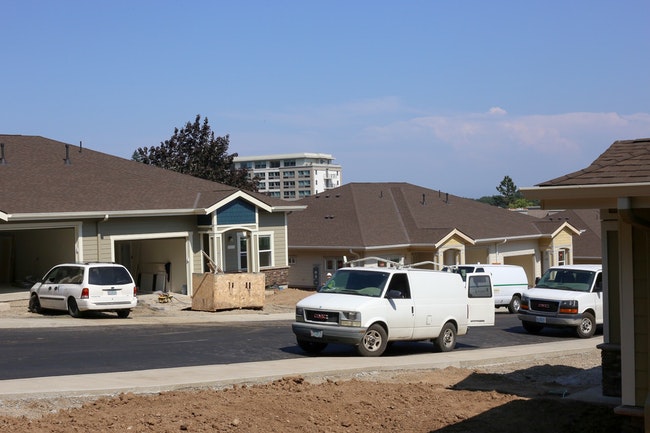 Capital Manor’s original tower stands in the distance while construction crews build 17 new duplexes to the west. (Troy Brynelson/Salem Reporter)
Capital Manor’s original tower stands in the distance while construction crews build 17 new duplexes to the west. (Troy Brynelson/Salem Reporter)
As Oregon prepares to implement a new law intended to spur the development of duplexes and small apartment buildings in cities like Salem, a disagreement has arisen over how much control local governments should have over zoning considerations.
In 2019, Oregon became the first state to effectively do-away with single-family zoning after lawmakers passed House Bill 2001. The law is intended to address the state’s housing crunch by making it easier to build less-expensive “missing middle” housing — duplexes, triplexes, fourplexes, cottage clusters and townhouses — in areas zoned for single-family housing.
The Oregon Department of Land Conservation and Development is currently developing rules to be completed later this year that will guide cities in implementing the new law.
Last week, the Oregon League of Cities sent the department a letter on behalf of nine cities, including Salem, expressing concern that cities would be left with “very little flexibility” and prevent them from pursuing their own housing strategies or responding to “community goals.”
The league’s letter asks that cities be allowed their own development standards and for minimum expectations from the state on just how much middle housing they should produce.
Michael Andersen, a senior researcher at Seattle-based sustainability think tank Sightline Institute, said that what the league is asking for would considerably water down the law.
“They make the claim that they could make more middle housing by banning middle housing, which makes no sense to me,” he said.
Ariel Nelson, lobbyist for the League of Oregon Cities, said that cities aren’t looking to sidestep the law’s requirements or prevent middle housing from being built. She said that the rules could make it harder for cities to preserve affordable housing or facilitate homeownership.
“Cities want to have tools and flexibility to go beyond and do more,” she said.
How the rules are written will affect neighborhoods across Oregon. Nearly two-thirds of Oregon’s homes were single-family houses, according to the most recent census. Over half the residential land in Salem is single-family, according to the city’s most recent housing needs assessment.
Salem City Planner Eunice Kim said the to recent changes the city already allows duplexes on corner lots and recently made it easier to build apartments. But the Salem City Council recently voted down an affordable housing project after pushback from a neighborhood association.
Salem Mayor Chuck Bennett said that the city is committed to the goals of House Bill 2001 and will implement it just as soon as the state issues its rules.
The new law specifically requires cities to allow duplexes on lots zoned single-family. However, where cities are required to allow for denser housing such as triplexes and fourplexes is ambiguous. The law states that cities must allow these denser developments in single-family residential “areas.”
Ethan Stuckmayer, senior planner of housing programs at the Department of Land Conservation and Development, said that the law seeks to give cities the ability right-size where middle housing can be built. He said the department is seeking to allow that right-sizing while preventing cities from excluding middle housing.
A state rule-making committee is currently determining how to define “areas,” which would determine how much leeway cities will have in restricting where triplexes, fourplexes, cottage clusters developments and townhomes can be built. According to committee materials, some cities may be justified in restricting this type of housing in areas that don’t have adequate infrastructure.
Nelson said that the league isn’t looking to give cities the ability to keep denser housing out of certain neighborhoods.
She said cities trying to create walkable neighborhoods may want to control the location of triplexes and duplexes to manage the flow of traffic. She said that the league wants to preserve the ability of cities to offer density bonuses as incentives to developers to build affordable housing. In gentrifying areas, cities may want to preserve older housing that’s affordable to existing residents, she said.
She pointed to the city of Springfield, which is trying to encourage homeownership by shrinking minimum lot sizes. She said neighborhood density would be skewed if a fourplex were to be built on a lot intended for a single-family home.
“It’s really about cities’ abilities to work within their communities and still meet the law’s intent,” she said.
Andersen said that the rules should instead broadly require cities to allow middle housing to be developed and allow exceptions only if there is a specific reason, such as increased traffic. He said he worried that the league’s request could give cities the ability to arbitrarily block the development of middle housing or stymie it with bureaucracy.
“I think the question Oregon is currently facing is whether (the new law) will be a chance for many cities to rethink and improve their zoning or to still allow a handful of cities to deliberately exclude certain Oregonians,” he said.
Oregon House Speaker Tina Kotek was the primary sponsor of the new law. A statement from her office indicated that she would be watching the rule-making process to make sure it isn’t watered down.
“The goal is to improve housing choice around the state by expanding access to middle housing options,” said the statement. “Local flexibility is important, but not at the expense of limiting choices, particularly in established neighborhoods.”
SUPPORT ESSENTIAL REPORTING FOR SALEM – A subscription starts at $5 a month for around-the-clock access to stories and email alerts sent directly to you. Your support matters. Go HERE.
Contact reporter Jake Thomas at 503-575-1251 or [email protected] or @jakethomas2009.









